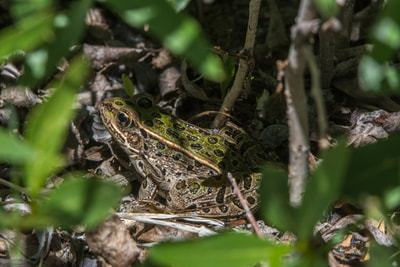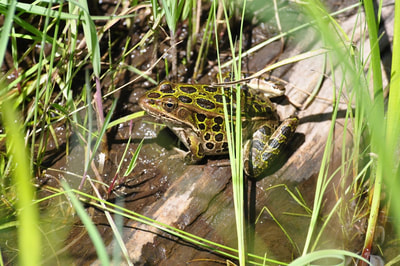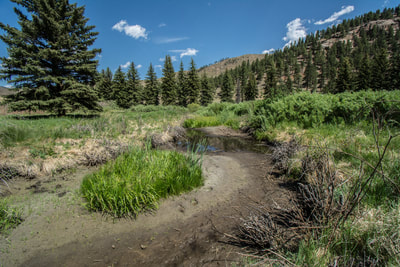Identification Green or brown, with large rounded or oval spots; smooth skin; eardrum usually lacks a light spot in the middle; dorsolateral folds not inset toward midline on rear; hind toes extensively webbed; rear of thigh with dark spotting. May reach up to 4.3 inches, but typically between 2.0-3.5 inches.
Identification (tadpole) Dark brown or olive to gray; when viewed from above the snout is pointed; eyes on top of head; iris gold and surrounded by dark spots; intestines coiled and often visible through skin of the belly; the tail makes up 65-80 % of total body length; anus is on the right side of the tail fin. Large tadpoles typically around 2.3 inches but may reach close to 4.0 inches.
Identification (eggs) Eggs are deposited in 2-6 inch wide, somewhat flattened globular masses containing hundreds or thousands of dark-colored eggs.
Voice The male Northern Leopard Frog's advertisement call usually consists of a low, rattling snore lasting 2-3 seconds followed by 2-3 series of stuttering chuckles, grunts, or croaks. Sometimes the two stages of the call are produced in reverse order, and sometimes one stage is produced without the other.
Habitat In Colorado this species occurs between elevations of 3,000 and 12,000 feet in a diversity of habitats, including wet meadows and the banks and shallows of marshes, ponds, glacial kettle ponds, beaver ponds, lakes, reservoirs, streams, and irrigation ditches. Northern Leopard Frogs are usually found at the water’s edge, though they may roam far from permanent water in wet meadows or during mild, wet weather.
Activity This species is most active March - October or November, though they have been observed in January and February in pools formed by warm groundwater. During cold winter months, Northern Leopard Frogs retreat to deep waters in ponds or streams where they remain inactive until spring. In general, Northern Leopard Frogs are most active at night.
Diet Adults eat a wide variety of invertebrates and some small vertebrate prey.
Predators In Colorado, known predators include the Pied-billed Grebe, Great Blue Heron, Burrowing Owl, Northern Watersnake, Western Terrestrial Gartersnake, and Western Tiger Salamander. Game fish are predators of all life stages of the Northern Leopard Frog. Elsewhere in the range, the Common Gartersnake, Plains Gartersnake, and American Bullfrog are known to prey on the Northern Leopard Frog.
Defensive behavior When disturbed, they may attempt to escape predators by hopping erratically or hiding in water or vegetation. In some habitats, the color of the skin may help Northern Leopard Frogs to escape detection. When harassed, the Northern Leopard Frog may lower the head, extend the elbows outward, and hold the forefeet close to the head in an apparent defensive posture.
Reproduction Northern Leopard Frogs may breed from mid-March through June in shallow, quiet areas of permanent water bodies, in seasonally flooded areas adjacent to or continuous with permanent pools or streams, and in beaver ponds. Females lay between 1,000 - 6,000 eggs in a roughly globular mass in shallow water, attached to plant stems or other objects. The eggs may hatch within several days to several weeks after they are laid, and tadpoles usually metamorphose 2-3 months later.
Conservation and status The once-abundant Northern Leopard Frog has become scarce in many areas as a result of habitat destruction, drought, and colonization by non-native American Bullfrogs. The Northern Leopard Frog is considered a Species of Concern by Colorado Parks and Wildlife and has been ranked a Tier 1 Species of Greatest Conservation Need (CPW 2015). The taking or possession of the Northern Leopard Frog in Colorado is prohibited without possession of a special license for scientific collecting, rehabilitation, education, or propagation.
Diet Adults eat a wide variety of invertebrates and some small vertebrate prey.
Predators In Colorado, known predators include the Pied-billed Grebe, Great Blue Heron, Burrowing Owl, Northern Watersnake, Western Terrestrial Gartersnake, and Western Tiger Salamander. Game fish are predators of all life stages of the Northern Leopard Frog. Elsewhere in the range, the Common Gartersnake, Plains Gartersnake, and American Bullfrog are known to prey on the Northern Leopard Frog.
Defensive behavior When disturbed, they may attempt to escape predators by hopping erratically or hiding in water or vegetation. In some habitats, the color of the skin may help Northern Leopard Frogs to escape detection. When harassed, the Northern Leopard Frog may lower the head, extend the elbows outward, and hold the forefeet close to the head in an apparent defensive posture.
Reproduction Northern Leopard Frogs may breed from mid-March through June in shallow, quiet areas of permanent water bodies, in seasonally flooded areas adjacent to or continuous with permanent pools or streams, and in beaver ponds. Females lay between 1,000 - 6,000 eggs in a roughly globular mass in shallow water, attached to plant stems or other objects. The eggs may hatch within several days to several weeks after they are laid, and tadpoles usually metamorphose 2-3 months later.
Conservation and status The once-abundant Northern Leopard Frog has become scarce in many areas as a result of habitat destruction, drought, and colonization by non-native American Bullfrogs. The Northern Leopard Frog is considered a Species of Concern by Colorado Parks and Wildlife and has been ranked a Tier 1 Species of Greatest Conservation Need (CPW 2015). The taking or possession of the Northern Leopard Frog in Colorado is prohibited without possession of a special license for scientific collecting, rehabilitation, education, or propagation.
Suggested citation Colorado Partners in Amphibian and Reptile Conservation. 2020. Northern Leopard Frog (Lithobates pipiens) Abbreviated Species Account. Compiled by Andrew M. DuBois. http://www.coparc.org/northern_leopard_frog [accessed date here]. Revised by Rémi Pattyn.
Last updated 4/14/2022 by Rémi Pattyn
Last updated 4/14/2022 by Rémi Pattyn
sources
- Ballinger, R. E., J. D. Lynch, and P. H. Cole. 1979. Distribution and natural history of amphibians and reptiles in western Nebraska with ecological notes on the herpetiles [sic] of Arapaho Prairie. Prairie Naturalist 11:65-74.
- Boone, M. D. Northern Leopard Frog. 2013. Pp 653-665 In Amphibians of Ohio. R. A. Pfingsten, J. G. Davis, T. O. Matson, G. J. Lipps, D. Wynn, and B. J. Armitage (eds). Ohio Department of Natural Resources.
- Cockerell, T. D. A. 1910. Reptiles and amphibians of the University of Colorado expedition of 1909. University of Colorado Studies 7(2):130-131.
- Conant, R., and J. T. Collins. 1998. A Field Guide to Reptiles and Amphibians of Eastern and Central North America. Third Edition. Houghton-Mifflin Company. Boston, Massachusetts. 616 p.
- Corn, P. S. 1981. Field evidence for a relationship between color and developmental rate in the northern leopard frog (Rana pipiens). Herpetologica 37:155-160.
- Hahn, D. E. 1968. A biogeographical analysis of the herpetofauna of the San Luis Valley, Colorado. M.S. thesis, Louisiana State University, Baton Rouge.
- Hamilton, W. J., Jr. 1941. A note on the food of the western burrowing owl. Condor 43:74.
- Hammerson, G. A. 1999. Amphibians and Reptiles in Colorado. 2nd ed. University Press of Colorado, Boulder, Colorado. 325 pp.
- Harding, J. H. 1997. Amphibians and reptiles of the Great Lakes Region. The University of Michigan Press. Ann Arbor, Michigan. Xvi + 378 p.
- Johnson, P. T. J., V. J. McKenzie, A. C. Peterson, J. L. Kerby, J. Brown, A. R. Blaustein, and T. Jackson. 2011. Regional decline of an iconic amphibian associated with elevation, land-use change, and invasive species. Conservation Biology 25:556–566.
- McAlpine, D. F., and T. G. Dilworth. 1989. Microhabitat and prey size among three species of Rana (Anura: Ranidae) sympatric in eastern Canada. Canadian Journal of Zoology 67:2244-2252.
- Minton, S. A. 2001. Amphibians and Reptiles of Indiana. Second edition. Indiana Academy of Science, Indianapolis. 404 p.
- Scott, N. J., and R. D. Jennings. 1985. The tadpoles of five species of New Mexican leopard frogs. Occasional Papers of the Museum of Southwestern Biology 3:1-21.
- Young, M. T. 2011. The Guide to Colorado Reptiles and Amphibians. Fulcrum Publishing, Golden, Colorado. 170 pp.
- Boone, M. D. Northern Leopard Frog. 2013. Pp 653-665 In Amphibians of Ohio. R. A. Pfingsten, J. G. Davis, T. O. Matson, G. J. Lipps, D. Wynn, and B. J. Armitage (eds). Ohio Department of Natural Resources.
- Cockerell, T. D. A. 1910. Reptiles and amphibians of the University of Colorado expedition of 1909. University of Colorado Studies 7(2):130-131.
- Conant, R., and J. T. Collins. 1998. A Field Guide to Reptiles and Amphibians of Eastern and Central North America. Third Edition. Houghton-Mifflin Company. Boston, Massachusetts. 616 p.
- Corn, P. S. 1981. Field evidence for a relationship between color and developmental rate in the northern leopard frog (Rana pipiens). Herpetologica 37:155-160.
- Hahn, D. E. 1968. A biogeographical analysis of the herpetofauna of the San Luis Valley, Colorado. M.S. thesis, Louisiana State University, Baton Rouge.
- Hamilton, W. J., Jr. 1941. A note on the food of the western burrowing owl. Condor 43:74.
- Hammerson, G. A. 1999. Amphibians and Reptiles in Colorado. 2nd ed. University Press of Colorado, Boulder, Colorado. 325 pp.
- Harding, J. H. 1997. Amphibians and reptiles of the Great Lakes Region. The University of Michigan Press. Ann Arbor, Michigan. Xvi + 378 p.
- Johnson, P. T. J., V. J. McKenzie, A. C. Peterson, J. L. Kerby, J. Brown, A. R. Blaustein, and T. Jackson. 2011. Regional decline of an iconic amphibian associated with elevation, land-use change, and invasive species. Conservation Biology 25:556–566.
- McAlpine, D. F., and T. G. Dilworth. 1989. Microhabitat and prey size among three species of Rana (Anura: Ranidae) sympatric in eastern Canada. Canadian Journal of Zoology 67:2244-2252.
- Minton, S. A. 2001. Amphibians and Reptiles of Indiana. Second edition. Indiana Academy of Science, Indianapolis. 404 p.
- Scott, N. J., and R. D. Jennings. 1985. The tadpoles of five species of New Mexican leopard frogs. Occasional Papers of the Museum of Southwestern Biology 3:1-21.
- Young, M. T. 2011. The Guide to Colorado Reptiles and Amphibians. Fulcrum Publishing, Golden, Colorado. 170 pp.





































